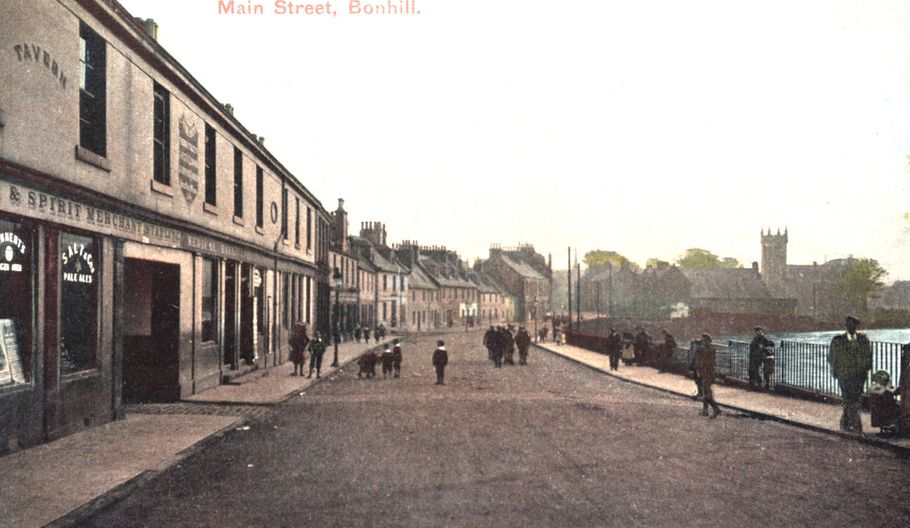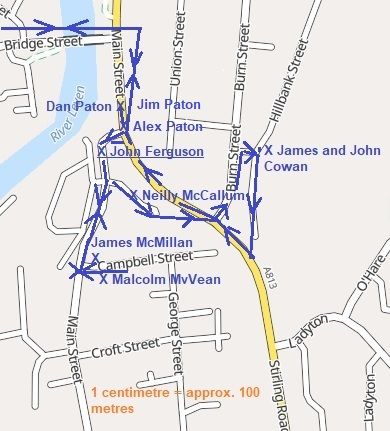The Bonhill Stroll
This is the story of eight lads, eight footballing teenagers, all attackers, and the player, once perhaps the best in the country but now reaching retirement, who must have been an inspiration but may also have been their trainer, indeed, to use a word they never would, their guru. The boys were in no particular order:
Jimmy & John Cowan Neilly McCallum
James Paton and their sage:
But back to the tale. There is in Scottish football history circles much discussion about "The Scotch Professors", players from Scotland, who took this country's then unique take on the game South, first into the shamateur and then the professional games in England. They came from not all Scotland but a variety of places within The Lowlands, disproportionately from the Vale of Leven. Renton was one hot-spot. Bonhill, as it turns out, was another.
Bonhill was a hard-working village cum small town, working class to the core. Football had come to it in 1872 and from it and Alexandria, the town on the opposite bank of the River Leven came Scotland's, indeed Britain's and therefore the World's first trophy-winning team that was not middle- or upper-class. Within five years Vale of Leven FC, "The Vale" based in Alexandria, would take the Scottish Cup, not once but three times in a row. Its star-player was print-field worker, Johnny Ferguson. He had been born up the river in Jamestown but later settled in Bonhill, eventually able to leave labouring for a living to become a "Licenced Grocer" in the village.
By then he had hung up his playing-boots but, whilst he was still kicking the leather in the top flight, a remarkable group of boys with footballing talent that was to be proven on the fields at home and in England began to emerge in the houses and streets around him. In 1881 James Cowan and Neilly McCallum were twelve, James McMillan eleven and John Cowan, James' younger brother and Malcolm McVean ten. And to them were added three siblings, the Paton brothers, who would come a little later to the group, the eldest James, fourteen in 1881, Alex, ten and Dan Paton, eight.
The Patons, like, Ferguson, would live on Main St., McVean and McMillan just off it on Campbell, whilst McCallum stayed one up on Burn and the Cowans' grandad one up still on Hillbank. In essence they all were much the same age, grew up within yards of each other and must have kicked a ball on the streets together, learning their trade.
And trade it would be. From local teams and then The Vale and/or Renton each would head South. For three, the Cowans and Dan Paton, it would be eventually to Birmingham and Villa. Paton, a forward, would not stay long but return to Scotland and with St. Bernard's take the Scottish Cup. John Cowan, also a forward would be an FA Cup- and Championship-winner, and Jimmy perhaps the greatest centre-half of his time, become a multiple trophy-winner and captain of both club and country.
McVean and McMillan, both inside-forwards, on the other hand, would head to Merseyside, the latter to Everton and the former to be part of Liverpool's Team of the Macs. Indeed it would be McVean, who would score the Anfield, in fact new Anfield club's first goal ever, then also score the first in the League and be club-captain. This was whilst McCallum, a winger, went to Nottingham via the scoring of Celtic's first ever goal and, after a first with Renton, a second Scottish Cup success with the Parkhead club. And finally Alex Paton's road would take him as a half-back to an FA Cup victory with Bolton Wanderers, whilst brother James would stay local apart from one appearance for Villa and be the centre-forward in the Vale of Leven team that alongside McMillan, before the latter headed South, would lose the 1890 Scottish Cup Final.
And as to John Ferguson's role in all this. In the vital years for a young player, never mind eight, he was there, still taking to the field himself and therefore presumably still interested. With the boys in their mid- teens he even , at the age of almost thirty-six, appeared in a fourth Scottish Cup Final, lost to neighbours, Renton, but only after a reply. His known to have coached and perhaps most damning of all, when he move to Kilmarnock, still in the Drinks Trade but it is said partly to coach, the Bonhill well would rapidly dry.
And so to the "Stroll", from the exit to Alexandria station take the path to the right down and to the station ring-road. Cross it into Bridge St. and continue down to the river and cross the bridge itself. On your way you will pass the places where several of the original Vale of Leven players were brought up. On the other side of the bridge turn right in to Bonhill Main St., where the Patons and Johnny Ferguson lived, taking the kink right after about two hundred yards and continuing on to the kirk on the right. Look left and there is Campbell St.. James McMillan stayed at No. 8, Malcolm McVean at Nos. 29 and 39.
Then retrace your steps to the next on the right. That is Burn St., No. 17 being the one time home of Neilly McCallum, who incidentally is buried in the village churchyard, the only one to be so. At the top end of Burn you will see steps. Climb them to Stirling St. and cross. That will take you into an extension of Burn, from which you take the first right. It leads into Hillbank, where the Cowans would be found at Grandad McAulay's at no.39.
And that it the end of tour. Turn right on Hillbank taking the path at the end to Stirling once more, where turning right will take you back to Main, the bridge and into Alexandria once more. In all it is about a mile but a packed one if you are a true Scottish football fan and buff. Moreover, there is more. Less than a decade later Tommy Galbraith would head South to Leicester from again Hillbank St. and John Docherty from Burn to Dumbarton, Celtic and back.
Back to The Leven Trails or the SFHGHome page

